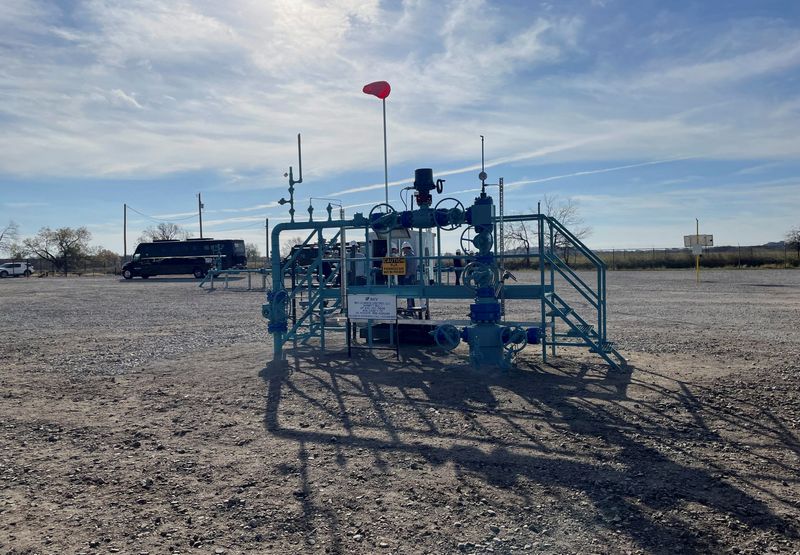Commodities
Tumbling US natural gas prices prove unstoppable, hurting producers


© Reuters. FILE PHOTO: A view of BKV Corp?s commercial carbon capture and sequestration project, in Bridgeport, Texas, U.S., December 7, 2023. REUTERS/Arathy Somasekhar/File Photo
2/2
By Arathy Somasekhar
BRIDGEPORT, Texas (Reuters) – For nearly a year, U.S. producers have slammed the brakes on production as prices fall. But relentless output gains including from oil companies that pump gas as an oil byproduct have unleashed record supplies.
In the oil versus gas contest, gas producers are losing out. Some are shutting in wells, canceling projects or selling themselves to rivals to avoid losses. Natural gas prices this month fell to an inflation-adjusted 30-year low of $1.59 per thousand cubic feet, benefiting consumers of the fuel like utilities, but hurting producers who are selling at nominal prices as low as they were in the depths of the COVID-19 downturn.
Nowhere is the pain of cheap gas as evident as Denver-based BKV Corp. In the last five years, it spent $2.7 billion to acquire 4,000 gas wells and two gas-fired power plants. It also pledged $250 million to build a dozen underground carbon capture and storage sites to make its gas more climate friendly.
The nosedive in U.S. gas prices has stalled BKV’s plans for an initial public offering and scuttled the carbon joint venture with Verde CO2 to couple its gas and power plants with carbon sequestration. BKV last year narrowly avoided loan defaults with a $150 million bailout by its parent.
Majority-owned by Thailand power giant Banpu Public Co., the little-known BKV in 2016 began buying scores of U.S. gas wells, taking castoffs from oil producers’ Exxon Mobil (NYSE:), Devon Energy (NYSE:) and others.
“We absolutely want to be the biggest natural gas producer in the country. That’s my ambition,” BKV Chief Executive Christopher Kalnin said in an interview here in December at its first carbon-sequestration site.
BKV’s profits soared to $410 million in 2022 on strong natural gas prices after Russia’s invasion of Ukraine spurred huge demand for exports of liquefied U.S. gas. The company launched a plan to build a U.S. version of its Thai parent, tying together natural gas and power. The plan included an IPO to help finance the gas-to-power expansion and a complement of carbon-burying wells.
CLIPPED WINGS
But BKV fell back to earth under prices suffering from a relentless expansion of U.S. natural gas output. Its profit fell to about $79 million in its most-recently reported nine-month period.
U.S. gas firms last year cut drilling 22% to stem the gusher. But the flows keep coming: The U.S. will pump 105 billion cubic feet a day of gas this year, up 2.5 billion cubic feet a day in the last year. That increase is enough to fuel 12.5 million U.S. homes for a day.
In most industries, volume increases are good. More production equals more profit. But rising output has overwhelmed efforts to curtail drilling and even demand from frigid temperatures, leading to a price drop that knocked U.S. gas recently to less than a third of 2022’s average $6.50 per million British thermal units. By contrast, benchmark WTI crude prices fell just 17%.
Oil prices have held steadier thanks to global supply cuts by major OPEC producers and their allies.
But soaring gas production, especially from oil companies who view gas as a byproduct of their output, has proven “relatively insensitive to prices,” said Nicholas O’Grady, CEO of U.S. shale gas explorer Northern Oil and Gas.
Gas producers have been reluctant to cut output deeply on the prospects of giant new liquefied natural gas (LNG) plants opening this decade, he said.
LNG exports would drain the excess gas supplies and should return prices to levels that make gas profitable to drill again by 2025, O’Grady and BKV’s Kalnin predict.
There are four U.S. projects with export permits on the drawing boards that would consume up to 6.3 billion cubic feet of gas that if they go ahead would be producing LNG later this decade.
The danger is that third wave of new LNG plants may be delayed or lost forever. President Joe Biden’s administration last month indefinitely paused reviews of new gas-export permits, jeopardizing as much as 32 billion cubic feet per day of future consumption.
U.S. natural gas producer Comstock Resources (NYSE:) said last week it would reduce the number of rigs in operation and suspend its dividend until gas prices rise sufficiently, while rival Antero Resources (NYSE:) said it would cut drilling and drop project spending budget by 26%.
‘PERFECT STORM’
BKV, short for Banpu Kalnin Ventures, began operations in Pennsylvania in 2016 with a plan to buy additional old gas fields from big oil companies, invest only enough to hold production steady, wait for prices to rise and – only then – invest in expanding production.
The moment appeared to arrive in mid-2022. As U.S. gas climbed to over $9 per thousand cubic feet, BKV’s Kalnin launched a costly and ambitious expansion plan.
In July that year, he closed on a $750 million deal for Exxon Mobil gas properties in North Texas. The same month, he acquired a Temple, Texas, gas-fired power plant for $460 million. Weeks later, he followed that deal with a $250 million partnership with Texas-based Verde CO2 LLC to build a dozen carbon sequestration sites across the United States.
“We didn’t see prices collapsing like they did,” said Kalnin at the opening of his first carbon sequestration site in December.
Kalnin, a former McKinsey consultant who spent his early years in Thailand and later worked for the country’s national oil and gas company, hasn’t given up on his gas-to-power empire.
“(Gas prices) are setting up for another fly-up in the second half of 2024,” Kalnin said in December, pointing to forecasts for rising LNG demand.
“There are micro windows for IPOs opening up,” a spokesperson added on Tuesday. “We are hoping to stay ready for when that micro window opens. Market performances for IPOs and gas prices need to improve,” she added.
Associated gas, which comes out of wells alongside oil, yanked the rug out from Kalnin’s vision. More than a third of all U.S. gas production comes from producers drilling for oil, according to government estimates. That figure is rising as wells mature and more gas comes up than oil.
BKV last year won a lifeline from its parent, selling shares to Banpu for $150 million to avoid breaching debt covenants. Most of the cash was put into a debt service account.
“You have this perfect storm. A warm winter plus too much gas supply, both primary and associated, and now, possible delays to new LNG export permits,” said Blake London, a managing partner of private equity fund Formentera Partners.
Commodities
Oil prices rise; U.S. crude inventories plunge, Russia-Ukraine truce eyed
Commodities
India’s Reliance to stop buying Venezuelan oil over US tariffs, sources say
Commodities
Oil prices climb on Venezuela supply worries

 Forex3 years ago
Forex3 years agoForex Today: the dollar is gaining strength amid gloomy sentiment at the start of the Fed’s week

 Forex3 years ago
Forex3 years agoUnbiased review of Pocket Option broker

 Forex3 years ago
Forex3 years agoDollar to pound sterling exchange rate today: Pound plummeted to its lowest since 1985

 Forex3 years ago
Forex3 years agoHow is the Australian dollar doing today?

 Cryptocurrency3 years ago
Cryptocurrency3 years agoWhat happened in the crypto market – current events today

 World3 years ago
World3 years agoWhy are modern video games an art form?

 Commodities3 years ago
Commodities3 years agoCopper continues to fall in price on expectations of lower demand in China

 Economy3 years ago
Economy3 years agoCrude oil tankers double in price due to EU anti-Russian sanctions





























